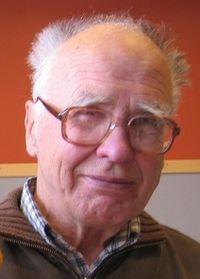Lennart Carleson facts for kids
Quick facts for kids
Lennart Carleson
|
|
|---|---|

Lennart Carleson in May 2006.
|
|
| Born | 18 March 1928 |
| Nationality | Swedish |
| Education | Uppsala University (PhD) |
| Known for | Carleson–Jacobs theorem Carleson measure Carleson's theorem Corona theorem |
| Awards | Abel Prize (2006) Sylvester Medal (2003) Lomonosov Gold Medal (2002) Wolf Prize (1992) ForMemRS (1993) Leroy P. Steele Prize (1984) |
| Scientific career | |
| Fields | Mathematics |
| Institutions | Royal Institute of Technology Uppsala University University of California, Los Angeles |
| Doctoral advisor | Arne Beurling |
| Doctoral students | Svante Janson Kurt Johansson Warwick Tucker |
Lennart Axel Edvard Carleson (born March 18, 1928) is a famous Swedish mathematician. He is known as a leader in a special area of math called harmonic analysis. This field studies waves and patterns. One of his most important achievements was proving something called Lusin's conjecture. In 2006, he received the Abel Prize. This award is like the Nobel Prize for mathematics. He won it for his deep and important work in harmonic analysis and the study of how systems change over time.
Contents
Early Life and Education
Lennart Carleson was born in Stockholm, Sweden. He was a student of another famous mathematician, Arne Beurling. Lennart earned his PhD (a high-level university degree) from Uppsala University in 1950.
After his PhD, he continued his studies at Harvard University in the United States. There, he met and talked with other mathematicians about Fourier series. These are special mathematical tools used to break down complex waves into simpler ones.
Career Highlights
Carleson has been a professor at several universities. These include Uppsala University and the Royal Institute of Technology in Stockholm. He also taught at the University of California, Los Angeles (UCLA).
From 1968 to 1984, he was the director of the Mittag-Leffler Institute. This is a well-known math research center near Stockholm. He also served as the president of the International Mathematical Union from 1978 to 1982. This organization helps mathematicians around the world work together.
Lennart Carleson married Butte Jonsson in 1953. They have two children, Caspar and Beatrice. He has also guided many students who were working on their PhDs.
Amazing Discoveries in Math
Lennart Carleson's work has helped solve some very difficult math problems. He used clever techniques from different areas of math. These included combinatorics, which is about counting and arranging things, and probability theory, which deals with chance.
Solving Big Problems
In the study of Hardy spaces (a type of function space), Carleson made important discoveries. He proved the corona theorem in 1962. He also showed that Fourier series for certain functions always come together (converge) almost everywhere. This is now known as Carleson's theorem.
This was a very old and famous problem. It was first thought about by Joseph Fourier in 1807. Later, Nikolai Luzin made it a clear problem in 1913, calling it Lusin's conjecture. Another mathematician, Kolmogorov, proved in 1923 that the conjecture was false for some functions. He even thought it must be false in general.
But 43 years later, in 1966, Carleson proved it was true for a wide range of functions. He presented his proof at a big math meeting in Moscow. His proofs were very complex at first. However, over time, mathematicians developed new tools that made his ideas easier to understand and use.
Carleson is also known for his work on Carleson measures. His ideas and methods have been very important in many areas of mathematics. He also solved a problem about quasiconformal mappings in 1974. These are special kinds of shape transformations.
Understanding Complex Systems
Carleson also worked in the field of dynamical systems. This area studies how systems change over time. For example, he worked on complex dynamics, which looks at how mathematical functions repeat themselves.
In 1991, he worked with Michael Benedicks to prove something important about strange attractors. These are patterns that appear in chaotic systems, like weather patterns. Their work helped create a new part of the study of dynamical systems.
Besides his many important research papers, Carleson has also written two books. One book, Selected Problems on Exceptional Sets (1967), is about potential theory. The other, Complex Dynamics (1993), is about how analytic functions repeat. He also helped publish the unreleased works of his teacher, Arne Beurling.
Awards and Honors
Lennart Carleson has received many top awards for his mathematical work.
- In 1992, he won the Wolf Prize in Mathematics.
- He received the Lomonosov Gold Medal in 2002.
- The Sylvester Medal was awarded to him in 2003.
- And, as mentioned, he won the Abel Prize in 2006.
He is a member of many important scientific groups around the world. These include the Norwegian Academy of Science and Letters and the Royal Society in the UK. In 2012, he became a fellow of the American Mathematical Society. He also has honorary doctorates from several universities, meaning they recognized his great achievements.
See also
 In Spanish: Lennart Carleson para niños
In Spanish: Lennart Carleson para niños

